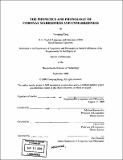| dc.contributor.advisor | Michael Kenstowicz and Cheryl Zoll. | en_US |
| dc.contributor.author | Kang, Yoonjung | en_US |
| dc.contributor.other | Massachusetts Institute of Technology. Dept. of Linguistics and Philosophy. | en_US |
| dc.date.accessioned | 2009-01-30T18:36:59Z | |
| dc.date.available | 2009-01-30T18:36:59Z | |
| dc.date.copyright | 2000 | en_US |
| dc.date.issued | 2000 | en_US |
| dc.identifier.uri | http://dspace.mit.edu/handle/1721.1/8844 | en_US |
| dc.identifier.uri | http://hdl.handle.net/1721.1/8844 | |
| dc.description | Thesis (Ph.D.)--Massachusetts Institute of Technology, Dept. of Linguistics and Philosophy, 2000. | en_US |
| dc.description | Includes bibliographical references (p. 191-202). | en_US |
| dc.description.abstract | This thesis investigates place feature restrictions in oral and nasal stop consonants with a special focus on the asymmetrical behavior of coronal and noncoronal stops. Two conflicting patterns of place restriction in outputs are attested: coronal unmarkedness and coronal markedness. This thesis shows that coronal unmarkedness is truly a default pattern of place restriction. Coronal unmarkedness is not confined to specific segmental contexts or to languages with a particular inventory structure. In addition, the coronal unmarked pattern is attested through diverse phonological processes such as assimilation, place neutralization, segmental and featural deletion, metathesis, vowel syncope and morpheme structure constraints. This follows from the context-free place markedness hierarchy proposed by Prince and Smolensky (1993). These constraints can conjoin freely with any context-specific constraints. Such conjunction predicts neutralization to coronal place to be attested in any position where place contrast reduction is found. On the other hand, although coronal markedness is also attested through diverse phonological processes such as assimilation, place neutralization, segmental and featural deletion, metathesis and morpheme structure constraints, it is found only in nonprevocalic positions and only in languages without a sub-coronal place contrast. I propose that unlike the default markedness constraint hierarchy, the reversed markedness hierarchy is projected from a perceptibility scale of place features and is therefore context-specific. I argue that a coronal stop in nonprevocalic position in a single-coronal language is perceptually less salient than noncoronal stops in corresponding positions due to a preferential weakening of tongue body articulation for coronal stops in these positions. Also discussed in this thesis is the effect of nasality of stops on the degree of place restrictions. A nasal stop tends to allow fewer place contrasts than an oral stop and a stop followed by an oral stop tends to allow fewer place contrasts than one followed by a nasal stop. Finally, previous approaches to coronal versus noncoronal asymmetry-Coronal Underspecification, Underspecification by Constraints and Perceptually Grounded Faithfulness Constraints are discussed and their inadequacy is demonstrated. | en_US |
| dc.description.statementofresponsibility | by Yoonjung Kang. | en_US |
| dc.format.extent | 202 p. | en_US |
| dc.language.iso | eng | en_US |
| dc.publisher | Massachusetts Institute of Technology | en_US |
| dc.rights | M.I.T. theses are protected by
copyright. They may be viewed from this source for any purpose, but
reproduction or distribution in any format is prohibited without written
permission. See provided URL for inquiries about permission. | en_US |
| dc.rights.uri | http://dspace.mit.edu/handle/1721.1/8844 | en_US |
| dc.rights.uri | http://dspace.mit.edu/handle/1721.1/7582 | en_US |
| dc.subject | Linguistics and Philosophy. | en_US |
| dc.title | The phonetics and phonology of coronal markedness and unmarkedness | en_US |
| dc.type | Thesis | en_US |
| dc.description.degree | Ph.D. | en_US |
| dc.contributor.department | Massachusetts Institute of Technology. Department of Linguistics and Philosophy | |
| dc.identifier.oclc | 48567849 | en_US |
